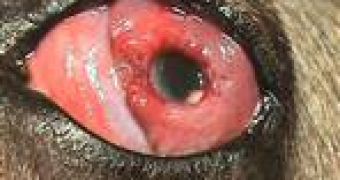It is said that dogs live in a world of scents. Imagine that, in humans, the olfactory mucosa is about 10 square centimeters, and in dogs of 150! Their hearing is also sharper than ours and they detect ultrasounds (the bats' sonar must be a nightmare for them). But this does not mean vision is not important for them.
Dixie, a 7-year-old Mountain Cur from Runnells, Iowa, became less active and adventurous since she went blind. Now, she can be herself again, due to a new plastic cornea she has received. "She used to walk right behind me when we'd go for a walk. She couldn't see and was scared. Now she wants to run ahead," said owner Brett Williams.
Dixie is the receiver of the first veterinary corneal implant in North America, and one of the first in the world. The surgery was performed by Sinisa Grozdanic, an assistant professor of Veterinary Clinical Sciences at the Iowa State University, who changed the dog's cloudy cornea with a permanent plastic one, which, unlike transplants of real corneas from other dogs, has less chances of being rejected.
The new type of cornea, a product of the German company Acrivet, has no rejection prone biomaterial. "Dixie was our patient for such a long time and nothing really worked. She was gradually going down visually and we were finally able to do something to definitely improve her quality of life," Grozdanic said.
In the world of today, human corneal transplant surgeries represent a routine operation. The first ones were performed in the early 1900s. Standard procedure has it that the new cornea is taken from a recently dead donor. Synthetic corneas for humans were developed for the first time just several years ago.
The plastic cornea doesn't provide Dixie with peripheral vision, but the dog has had part of her vision restored: following the operation, Dixie could visually track a cotton ball that was being moved in front of her.
Dog vision
Dogs are myopic, or nearsighted, and this increases with age. They have binocular vision like ours, at some 180 degrees, but weaker. They are also color-blind, detecting mainly degrees of color intensity as various shades of gray; their eyes are more wired to detect movement, which helps them when hunting and for survival. The fovea, the eye's focusing spot, is not as evolved as in humans, decreasing a dog's ability to have the clear vision that humans have. Dogs have a poor sense of depth, distance, and detail.
This is the situation during the day. However, when night falls, they have an advantage over us. Dogs have pupils larger than we humans do, which help them gather more light when it's scarce. Their retina has more night-vision cells (rods) than ours does, which react to lower light amounts than cones, but do not inform about color.
You know that a dog's eyes (and of all carnivores, crocodiles and other night creatures) glow in the dark because of the tapetum. The tapetum is a mirror-like layer in the back of the eye reflecting light and enabling the retina to be turned on twice by the light that has penetrated into the eye. Although the tapetum improves vision in dim light, it also scatters some light, degrading the dog's vision from the 20:20 in humans to about 20:80.

 14 DAY TRIAL //
14 DAY TRIAL //